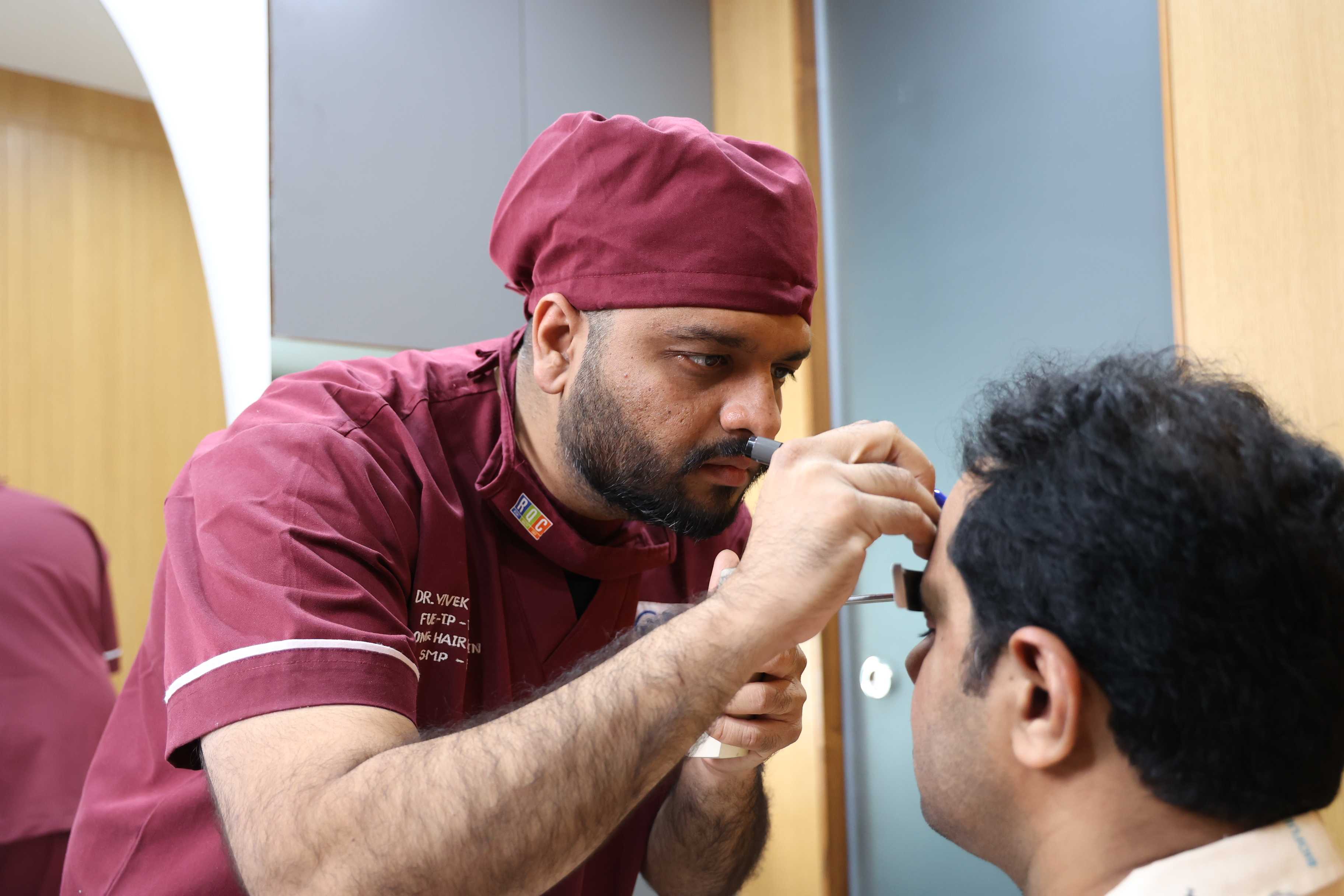

A hair transplant is a minimally invasive procedure that involves moving hair follicles from one part of your scalp (Donor Area - Back of the head), usually where hair is fuller, to areas where hair is thinning or has been lost (Recipient Area - Bald patches where you want to grow hair). It’s a safe and effective solution for men experiencing hair loss due to genetics, aging, or other factors.
RQC is one of the best hair transplant in India, we specialize in providing state-of-the-art hair transplant procedures that deliver natural, lasting results. Whether you're dealing with early thinning or advanced baldness, our personalized approach ensures the best outcomes for you.

Step 1: Initial Consultation
The purpose of this consultation is to assess your current situation, understand your expectations, and guide you through all the possible end results. We are here to help you make the best decision for your hair health, and for that, you have two great options to get started:
1️⃣ Exclusive 1-to-1 Video Consultation with Dr. Vivek Galani (Chief Hair Transplant Surgeon at RQC)
📅 Get personalized advice directly from me.
💡 Discuss your concerns and receive a tailored treatment plan.
💰 Consultation Fee: 799/- INR • Payment Link: https://rzp.io/l/yMtrMdyG
2️⃣ Free Hair Assessment
📝 Fill out a quick form, and our experts will provide a customized assessment for you.
🚀 Click here to start your free assessment: https://forms.gle/rnmNmd2cTwEqeePi8
Step 2: Hair Transplant
Step 3 - Post Procedure Care
Aftercare instructions play a very important role in ensuring smooth recovery and the best possible results.
There are many advanced technologies available for performing a hair transplant in 2024, but we believe that no single technology is the best for every client. Since everyone's hair is different, the stage of hair loss, and the need for hair grafts vary, this calls for personalized and specific technology selection for maximum output.
Here is the schedule for hair transplant planning:
Result Timelines
At RQC Hair Transplant Clinic, we believe in providing value and are committed to:
All you need for this is:
I am Parvez ilyasbhai Mansuri . From Zankhav Gujarat. I am a car mechanic I am suffered hairfall problem last two years and also i take medicine for it but I don't get sufficient result. Onday while using instagram I found the name" RQC The hair tr...
Read More
Hi there, my name is parimal modi and i am from australia. i have hairfall problem and i got reference of Dr. vivek galani and then i took consultation. he is so kind. he answered all of my questions in very good manner. i had my sugery 7 days ago an...
Read More
Its been 9 months approx my hair transplant surgery and I completely satisfied and happy with my result . Team at rqc is brilliant and they took proper care between these months by proper reminders and msg. And solve all my queries whenever I needed...
Read More
hi there, my name is vikas and i am from surat. it's been 1.5 years of my hair transplant surgery and i am so happy with my results. you can clearly see my well growing hairs. . I had to update this year I had completed more than 2 yrs of my surger...
Read More
I can't express enough gratitude to RQC hair transplant centre for the incredible hair transplant they performed. The entire team at the clinic was incredibly friendly and made me feel at ease throughout the entire process. The clinic itself was well...
Read More
Everything is set brother. There is no point in tension It is a very big clinic, many people have doubts as to how it will be done but visit it. It will make a difference😇
Read More
Hello my name is Narendra sengar and I am from chandrapur Maharashtra. I had my surgery 2 years ago and I had a great result. I am very satisfied with the rqc team work . They always guide whenever you have a queries and always answer my call and MSG...
Read More
Deepak Jain here, from khandwa (MP). My hair transplant was done two days ago, and Dr. Vivek Galani had set everything up in a very nice way. Everything happened in the same way, there was a ghost in the beginning but it did not work after the proced...
Read More
Hello, My Name Is Jaydip From Surat, kayargam And I Come in for hair transplant in this hospital. My review for this :- There behaviour are good and here all are very supportive and give best facilities thanks to all doctors and nurses for this. Spe...
Read More
Hi there, my name is parimal modi and i am from australia. i have hairfall problem and i got reference of Dr. vivek galani and then i took consultation. he is so kind. he answered all of my questions in very good manner. i had my sugery 7 days ago an...
Read More
It was good experience at dr.vivek galani’s clinic. I came to know about dr.galani’s from google . Consultation experience was good as he explains in detail about hair transplantation process so you get the idea about everything.Staff’s behaviour was...
Read More
I recently had a hair transplant in RQC and I would say that I was really impressed with Dr Vivek and the Staff. It is a must visit place if you have any type of hair problem. The staff is very good and is always ready for your help. Dr Vivek a very...
Read More
My name is kamlesh nikum and I am from vapi. Approx one year ago I did my beard transplant surgery from Dr. Vivek galani's RQC hair transplant clinic and I'm beyond excited to share my experience with the hair transplant clinic! They were absolutely...
Read More
I am Parvez ilyasbhai Mansuri . From Zankhav Gujarat. I am a car mechanic I am suffered hairfall problem last two years and also i take medicine for it but I don't get sufficient result. Onday while using instagram I found the name" RQC The hair tr...
Read More
My name is Hitesh Patel and I am from bharuch .it's been 1 week of my surgery and I had visited today for hairwash and my surgery day was very good. I was scared before but during surgery they make me feel comfortable and explained every process to...
Read More
My name Saurabh sumbe and I had my hair transplant surgery at rqc clinic on 11 sept . Starting from hair line planning I was very excited to experience what is for the day and how it will be and whenever you think of surgery it makes you scared but...
Read More
No, the hair transplant procedure is performed under local anesthesia, which means you will not feel pain during the process. You might experience some mild discomfort or soreness in the treated area after the procedure, but this can usually be managed with over-the-counter pain relievers.
You can expect a shedding phase within 3 to 4 months post-procedure. Noticeable improvement usually occurs around 6 to 9 months, and the final results can be seen between 12 to 18 months as the hair continues to thicken and grow naturally.
Yes, the transplanted hair is your own natural hair, carefully placed to match your existing hair's direction, angle, and pattern. At RQC Hair Transplant Clinic, we use advanced techniques to ensure the results blend seamlessly with your original hair, giving you a completely natural appearance.
Hair transplants are generally safe procedures with minimal risks. Some temporary side effects may include redness, swelling, or scabbing at the graft sites, which typically subside within a few days to a week. Serious complications, such as infection or scarring, are rare but can be minimized with proper aftercare and following your surgeon’s instructions.
The number of sessions required depends on the extent of your hair loss, your goals, and the density you desire. Some patients achieve their desired results in a single session, while others may need multiple sessions for optimal coverage and density, especially if hair loss progresses over time.
Transplanted hair is resistant to the effects of DHT, the hormone responsible for male pattern baldness, making it a long-lasting solution.
